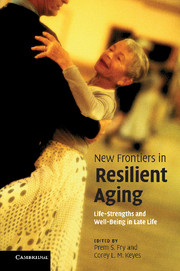Book contents
- Frontmatter
- Contents
- Figures
- Notes on contributors
- Foreword
- Acknowledgments
- Introduction
- 1 Sources of human life-strengths, resilience, and health
- 2 Growth is not just for the young: growth narratives, eudaimonic resilience, and the aging self
- 3 Physical resilience and aging:
- 4 You can teach an old dog new tricks:
- 5 Resilience in the face of cognitive aging:
- 6 Why do some people thrive while others succumb to disease and stagnation?
- 7 Psychosocial resources as predictors of resilience and healthy longevity of older widows
- 8 Resilience and longevity:
- 9 The socioemotional basis of resilience in later life
- 10 Emotional resilience and beyond:
- 11 Risk, resilience, and life-course fit:
- 12 Resilience in mobility in the context of chronic disease and aging:
- 13 Positive aging:
- Index
- References
4 - You can teach an old dog new tricks:
harnessing neuroplasticity after brain injury in older adults
Published online by Cambridge University Press: 06 December 2010
- Frontmatter
- Contents
- Figures
- Notes on contributors
- Foreword
- Acknowledgments
- Introduction
- 1 Sources of human life-strengths, resilience, and health
- 2 Growth is not just for the young: growth narratives, eudaimonic resilience, and the aging self
- 3 Physical resilience and aging:
- 4 You can teach an old dog new tricks:
- 5 Resilience in the face of cognitive aging:
- 6 Why do some people thrive while others succumb to disease and stagnation?
- 7 Psychosocial resources as predictors of resilience and healthy longevity of older widows
- 8 Resilience and longevity:
- 9 The socioemotional basis of resilience in later life
- 10 Emotional resilience and beyond:
- 11 Risk, resilience, and life-course fit:
- 12 Resilience in mobility in the context of chronic disease and aging:
- 13 Positive aging:
- Index
- References
Summary
Abstract
Animal and human research has shown that the brain can reorganize and even remodel itself to restore function in response to central nervous system (CNS) injuries, such as stroke, traumatic brain injury, and spinal cord injury. This chapter will discuss the phenomenon of neuroplasticity after damage to the CNS demonstrated in animal and human experiments. Research on Constraint-Induced Movement therapy or CI therapy, which is a behaviorally based approach to physical rehabilitation, will be a major focus. This body of work, among other contributions, overthrew the reigning clinical wisdom that stroke survivors more than 1-year post-event can not benefit from additional physical rehabilitation. It also provided the first evidence that physical rehabilitation can produce large improvements in real-world arm function and change CNS organization and structure. This evidence provides a neurophysiological basis for continued plasticity in behavior among older adults.
Introduction
Clinical wisdom, and even the scientific view, until relatively recently was that older adults who suffered damage to their brain had little hope that this vital organ could repair itself or adapt how it functioned to overcome the injury. The scientific view was based on the long-held tenet that the mature central nervous system (CNS) had little capacity to repair or reorganize itself. Though contrary views were expressed (e.g., Flourens, 1842; Fritsch and Hitzig, 1870; Lashley, 1938; Munk, 1881), the mature CNS was generally believed (Kaas, 1995, p. 735) to exhibit little or no plasticity (e.g., Hubel and Wiesel, 1970; Ruch, 1960, p. 274).
- Type
- Chapter
- Information
- New Frontiers in Resilient AgingLife-Strengths and Well-Being in Late Life, pp. 104 - 129Publisher: Cambridge University PressPrint publication year: 2010
References
- 3
- Cited by



